 NVIDIA
NVIDIA
Powering the AI Revolution
A member of Mag7, NVIDIA Corporation is a leading American technology company known for its Graphics Processing Units (GPUs) and overall contributions to computer graphics, AI, and high-performance computing. From its beginnings as a graphics startup, NVIDIA's rise to an AI and computing giant highlights its ability to innovate and adapt to technological shifts. Its GPUs are now important not just for gaming, but also for AI, scientific research, and autonomous vehicles. NVIDIA's AI technology is at the heart of the generative AI boom, making it one of the most valuable companies in the world.
 NVIDIA History
NVIDIA History
Founding and Early Years (1993-1999)
NVIDIA was founded on April 5, 1993, in the Silicon Valley community of Sunnyvale, California, by Jensen Huang, an electrical engineer who was a microprocessor designer at AMD; Chris Malachowsky, an engineer who worked at Sun Microsystems; and Curtis Priem, who was a graphics chip designer at IBM and Sun. With a vision to bring 3D graphics to the gaming and multimedia markets, the stated goal of the young company was to revolutionize computer graphics by creating powerful and efficient GPUs.
We also observed that video games were simultaneously one of the most computationally challenging problems and would have incredibly high sales volume. Those two conditions don't happen very often. Video games was our killer app; a flywheel to reach large markets funding huge R&D to solve massive computational problems.
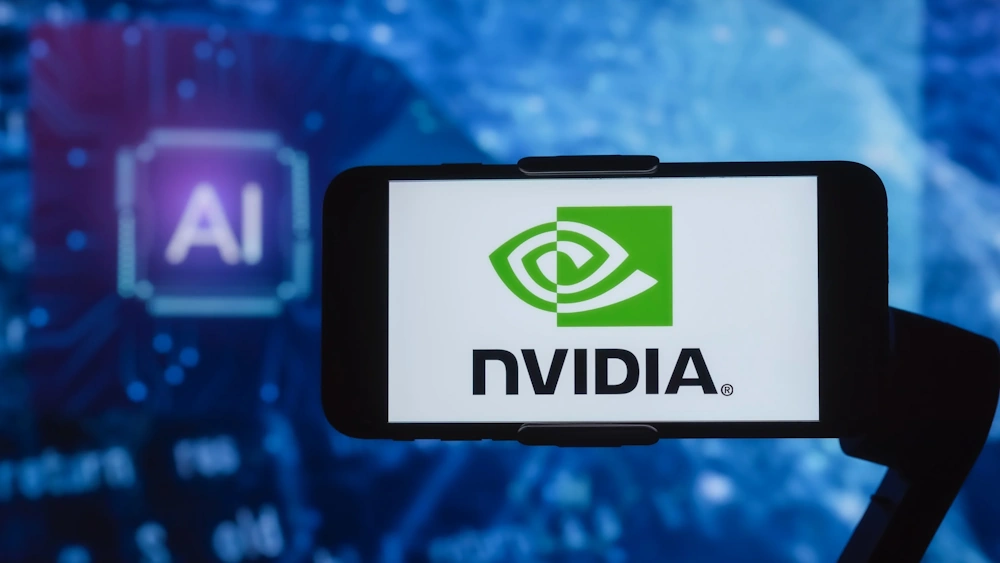
NVIDIA NV1
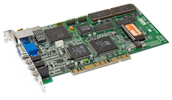
Two years after starting the company, with funding from Sequoia Capital, Sutter Hill Ventures and other VCs, NVIDIA released its first product, the NV1. The NV1 was an ambitious yet ultimately unsuccessful product that taught NVIDIA important lessons for future products.
The NV1 was a so-called multimedia accelerator for PCs, which included 2D and 3D graphics, along with audio capabilities. The NV1 combined 2D, 3D, video, and sound in a single chip. For 3D rendering, it used quadratic texture mapping, an unconventional method that didn't catch on in the industry. Most games then used polygon-based 3D (triangles), but the NV1 instead used quadratic surfaces, which were harder to develop for, so few game developers adopted the technology. Also, there was no Direct3D/OpenGL support. Microsoft's Direct3D with OpenGL was the standard at the time, but the NV1 used a proprietary API. The NV1 was so obscure that very few working units exist today, making it a rare collector's item.
NVIDIA RIVA 128 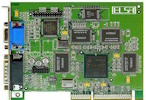
After the NV1 flopped, NVIDIA was on the brink of failure. The Real-time Interactive Video and Animation accelerator (RIVA), introduced in 1997, saved the company. The RIVA 128 was a successful 3D graphics accelerator that competed with 3dfx and ATI, leading graphics card companies at the time.
The RIVA 128 used industry-standard 3D, dropping the NV1's unpopular quadratic rendering in favor of polygon-based 3D using triangles. It was compatible with Direct3D and OpenGL, the APIs game developers actually used. It had blazing speed for its time with 100 Mbps memory bandwidth, and 1.6 million polygons per second which outpaced rivals like the 3dfx Voodoo in raw specs. The RIVA 128 combined 2D and 3D acceleration in one chip unlike the 3dfx, which required a separate 2D card. It was competitively priced at $250 which was cheaper than buying multiple cards. The RIVA 128 was used by Diamond Multimedia, a top graphics card maker at the time. Finally, again unlike the NV1, it supported Microsoft DirectX, ensuring game compatibility.
NVIDIA GeForce 256 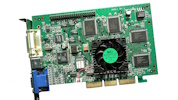
In 1999, NVIDIA launched the GeForce 256, marketed as the world's first GPU. The GeForce 256 introduced Transform and Lighting (T&L), , a major leap in 3D graphics rendering.
The GeForce 256, launched on August 31, 1999, was a revolutionary graphics chip that defined the term "GPU" (Graphics Processing Unit). It marked NVIDIA's transition from a struggling graphics card maker to an industry leader, setting the foundation for modern 3D graphics and computing. The GeForce 256 was an industry game-changer. It was the first GPU with Hardware Transform and Lighting (T&L). Before the GeForce 256, CPUs handled all 3D geometry calculations which were slow and inefficient. The GeForce 256 offloaded these tasks to the GPU, enabling ten times more polygons per second and more complex 3D worlds used in popular games like Unreal Tournament and Quake III.
 NVIDIA Stock
NVIDIA Stock
On January 22, 1999, NVIDIA went public on the NASDAQ Stock Exchange (stock symbol NVDA) at $12 per share. NVIDIA stock has generated some of the greatest returns in market history, transforming early investors into millionaires. A $1,000 investment at NVIDIA's initial public offerring would be worth $5 million today, making it one of the best-performing stocks in the history of the stock exchange.
The news that ChatGPT was trained on an NVIDIA supercomputer spurred one of the largest single-day gains in stock-market history. When the NASDAQ opened on May 25, 2023, NVIDIA's value increased by about two hundred billion dollars. A few months earlier, Jensen Huang, NVIDIA's CEO, had informed investors that NVIDIA had sold similar supercomputers to fifty of America's hundred largest companies. By the close of trading, NVIDIA was the sixth most valuable corporation in the world, worth more than Walmart and ExxonMobil combined.
NVIDIA's AI monopoly on GPUs suggests the run isn't over yet, and NVIDIA tops our list of best AI stock tips.
Expansion and Innovation (2000-2009)
NVIDIA acquired 3dfx Interactive's assets, strengthening its position in graphics
In December 2000, NVIDIA acquired the assets of 3dfx Interactive, a major competitor that was once the king of PC gaming graphics, for $70 million in cash and 1 million shares of NVIDIA stock. NVIDIA gained key intellectual property with over 300 GPU patents and human talent, engineers who later worked on GeForce products.
NVIDIA GeForce 3 began the rise of programmable graphics
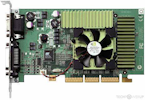
Launched in February 2001, the GeForce 3 advanced GPU technology by introducing programmable shaders, the foundation of all modern graphics. It enabled effects like per-pixel lighting, water reflections, and dynamic shadows. It was NVIDIA's answer to Microsoft's DirectX 8 and set the standard for next generation 3D rendering.
NVIDIA introduced CUDA in 2007 with the release of the GeForce 8800 GPU
CUDA, which is an acronym for Compute Unified Device Architecture, is NVIDIA's parallel computing platform, a technology that transformed GPUs from graphics processors into supercomputing engines perfect for AI.
The CUDA technology lets software use the power of a GPU for tasks beyond just graphics, like scientific computing, AI, and video processing. Unlike CPUs which are good at complex, sequential tasks, GPUs are fast at parallel tasks. GPUs excel at handling many simple calculations at once. CUDA Allows GPUs to do more. Normally, GPUs just render graphics, but CUDA lets programmers use them for general computing tasks like machine learning, physics simulations, etc.. Developers write code in CUDA languages like C, C++, or Python and use libraries like PyTorch and TensorFlow to make the GPU work on non-graphics tasks.
2006: Released the Tesla architecture, marking NVIDIA's entry into high-performance computing (HPC).
2008: Faced financial struggles due to the global recession but rebounded with a focus on GPU computing.
Growth in AI, Gaming, and Data Centers (2010-Present)
2012: The GeForce GTX 680 (Kepler architecture) set new standards for power efficiency and performance in gaming GPUs.
2014: Entered the automotive market with Tegra processors for infotainment and autonomous driving.
2016: Launched the Pascal architecture (e.g., GTX 1080), a major leap in performance and VR readiness. AI boom began, with NVIDIA GPUs becoming essential for deep learning (e.g., Tesla P100 for data centers).
2017: Introduced Volta architecture, featuring Tensor Cores for AI acceleration.
2018: Stock price surged due to AI and data center demand. Launched RTX 20-series, introducing real-time ray tracing with Turing architecture.
2020: Acquired Mellanox ($6.9B) to boost data center and networking capabilities. Announced Arm acquisition (later abandoned in 2022 due to regulatory hurdles). Released Ampere architecture (e.g., RTX 3090, A100 for AI).
2022: Launched Hopper architecture (H100), a powerhouse for AI and supercomputing. Faced a crypto downturn as GPU demand from miners declined.
2023-2024: Dominated the AI boom with its GPUs powering ChatGPT and other large language models (LLMs). Unveiled Grace Hopper Superchip for AI data centers. Market cap surpassed $1 trillion, making it one of the most valuable companies in the world.
2025:
 Key Business Segments Today
Key Business Segments Today
- Gaming (GeForce GPUs): Still a core revenue driver.
- Data Center (A100/H100, DGX systems): Major growth area due to AI.
- Professional Visualization (Quadro, RTX Workstations).
- Automotive (Drive platform for self-driving cars).
- AI and Omniverse: Simulation and virtual collaboration platforms.
Why does NVIDIA Dominate AI?
- Best AI Hardware (H100, Blackwell)
- CUDA and Software Ecosystem (Lock-in Effect)
- Early Bet on Deep Learning and LLMs
- Cloud and Enterprise AI Adoption
 Founder
and CEO
Founder
and CEO
Jen-Hsun (he prefers "Jensen") Huang has been CEO since co-founding the company in 1993, making
him one of the longest-serving tech CEOs.
Of all the Mag7 tech titans, Jensen Huang came from the humblest background. Born in Taiwan, he moved to the U.S. as a child. In his youth, he worked as a dishwasher, cleaned toilets, and survived mistreatment at a kids camp. At the age of 16, he enrolled at Oregon State University to study electrical engineering. After graduation, he began work designing microchips for AMD, attending Stanford evening courses for his Master's degree.
The Nvidia Way: Jensen Huang and the Making of a Tech Giant
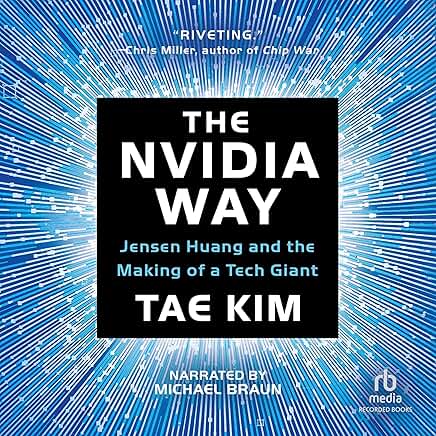
 NVIDIA's AI Hardware: GPUs and Accelerators
NVIDIA's AI Hardware: GPUs and Accelerators
NVIDIA has become a dominant force in artificial intelligence (AI), providing the hardware and software that drive machine learning, deep learning, and large-scale AI models. Here's how NVIDIA is shaping the AI landscape:
GPU Architectures for AI
NVIDIA's GPUs evolved from gaming to become the backbone of AI training and inference
- Tesla (2006): First CUDA-capable GPUs for general-purpose computing.
- Kepler (2012): Early AI/Deep Learning support.
- Pascal (2016): Boosted AI performance with mixed-precision computing.
- Volta (2017): Introduced Tensor Cores (specialized AI cores for matrix math).
- Ampere (2020): A100 GPU with 3rd-gen Tensor Cores, sparsity acceleration, and massive memory (80GB HBM2e).
- Hopper (2022): H100 GPU with Transformer Engine (optimized for AI models like GPT-4).
- Blackwell (2024): Next-gen AI superchip (B100/B200) for trillion-parameter AI models.
AI Supercomputing and Data Center Solutions
- DGX Systems - AI supercomputers (e.g., DGX H100) used by OpenAI, Microsoft, and Meta.
- HGX - Modular AI server platforms for cloud providers.
- Grace Hopper Superchip - Combines Arm-based Grace CPU + Hopper GPU for AI workloads.
NVIDIA's AI Software Ecosystem
CUDA and cuDNN
Over 4 million developers use CUDA, and nearly every major AI breakthrough in the last decade has been powered by NVIDIA GPUs.
- CUDA - Parallel computing platform enabling GPU acceleration for AI.
- cuDNN - Deep Neural Network library optimized for NVIDIA GPUs.
AI Frameworks and Libraries
- TensorRT - High-performance deep learning inference optimizer.
- RAPIDS - GPU-accelerated data science (Python libraries like cuDF, cuML).
- NeMo - Framework for building and deploying large language models (LLMs).
AI Cloud and Enterprise Solutions
- NVIDIA AI Enterprise - End-to-end AI software suite for businesses.
- NVIDIA AI Foundations - Cloud services for custom LLMs (e.g., BioNeMo for biology).
 Key AI Applications Powered by NVIDIA
Key AI Applications Powered by NVIDIA
These are just a few of the key AI applications powered by NVIDIA technology.
Large Language Models and Generative AI
- ChatGPT, GPT-4, Claude, and other LLMs are trained on NVIDIA A100/H100 GPUs.
- NVIDIA NeMo helps companies build custom chatbots and AI assistants.
Data Centers and AI Infrastructure
- DGX Systems
- A100/H100 GPUs
- Certified Servers
Computer Vision and Autonomous Vehicles
- DRIVE Platform - Powers self-driving cars (Tesla initially used NVIDIA before switching to in-house chips).
- Clara - AI for healthcare imaging (MRI, CT scans).
Robotics and Edge AI
- Jetson - AI computing for robots, drones, and IoT devices.
- Isaac Sim - Robotics simulation powered by AI.
Science and Research
- BioNeMo - AI for drug discovery and biology.
- Climate & Physics Simulations - Used in weather forecasting and nuclear fusion research.
 NVIDIA's AI Partnerships
NVIDIA's AI Partnerships
- Cloud Providers: AWS, Google Cloud, Azure, and Oracle Cloud offer NVIDIA H100 instances.
- AI Startups: OpenAI, Anthropic, Mistral, and others rely on NVIDIA GPUs.
- Chip Competitors: NVIDIA leads in AI acceleration, competing with AMD (MI300X) and custom AI chips like the Google TPU and AWS Trainium.
 NVIDIA Blackwell
NVIDIA Blackwell
The NVIDIA Blackwell architecture represents the latest leap in GPU technology, specifically designed for AI, high-performance computing, and generative AI workloads in 2025. NVIDIA Blackwell signifies a transformative step in GPU technology, leveraging innovative design, extreme scalability, and security features to meet the demands of AI's future landscape.
Key Features
- Advanced Manufacturing: Built with 208 billion transistors using 4NP process, supporting high efficiency and performance. Made in a new facility in Arizona.
- Scale and Connectivity: The architecture seamlessly connects two dies with a 10 TB/s interconnect, supporting massive scalability across GPU clusters; up to 576 GPUs via the fifth-generation NVLink.
- AI Focus: Equipped with NVIDIA's second-generation Tensor Cores, featuring new precisions like FP4 and MXFP4/MXFP6 microscaling formats, optimized for generative AI inference and training, doubling the performance of previous models.
- Confidential Computing: The architecture introduces industry-leading hardware-based security, enabling confidential AI training and inference with minimal performance trade-offs.
- Performance: Blackwell GPUs, particularly the GB202 die, feature 24,576 CUDA cores, surpassing previous generations in both core count and efficiency, with native support for sub-8-bit data types.
The first Blackwell chips have been manufactured in a TSMC facility in Arizona, highlighting significant manufacturing advancements and local production efforts. Despite initial manufacturing challenges and design flaws, Blackwell GPUs are already sold out, underscoring immense market demand. These GPUs are expected to power AI factories for large language models, generative AI, and exascale computing, marking a new era of AI hardware.
Blackwell is positioned as a cornerstone for AI acceleration, with applications spanning enterprise AI, data centers, and potentially consumer devices like AI-driven smart systems. Its introduction reinforces NVIDIA's leadership in AI hardware and computing infrastructure for the upcoming generation of AI models. The NVIDIA Blackwell architecture is the successor to the highly successful Hopper architecture (used in the H100 and H200 chips) and represents NVIDIA's latest, most powerful platform specifically designed for the demands of the current generative AI boom. It is engineered to handle the training and deployment of trillion-parameter scale models, pushing the boundaries of what is possible in large language models (LLMs) and complex simulations.
Here is a breakdown of Blackwell's key features and significance:
- Massive Scale and Transistor Count: The most striking feature of Blackwell is its sheer size and complexity.
- Chip Design: The Blackwell GPU is not a single, monolithic chip but rather two large silicon dies interconnected at a very high bandwidth. This design approach is necessary to achieve the desired performance while maintaining manufacturing feasibility.
- Transistors: The Blackwell architecture contains an immense number of transistors, significantly surpassing its predecessors. This density provides the computational substrate needed to run modern, extremely parallel AI workloads. The ability to execute operations simultaneously across numerous points, the parallel architecture, continues the trend noted in the previous discussions about why GPUs (like those from the 2012 AI renaissance) are so effective for neural network training.
- Second-Generation Transformer Engine: Blackwell introduces an advanced version of the Transformer Engine, which is crucial for maximizing efficiency when working with LLMs (which are based on the Transformer architecture).
- Floating-Point Formats: This engine is designed to intelligently utilize multiple precision formats (like FP4, FP8, and FP16) within the neural network training and inference process. This is vital because lowering precision (e.g., moving from 16-bit to 4-bit numbers) dramatically reduces the memory and computational requirements without significantly sacrificing the model's accuracy.
- Speed for LLMs: This specialization accelerates the single most compute-intensive part of generative AI workloads--the attention mechanism within the Transformer model--leading to massive speedups, particularly for inference (when the model is generating text or images).
- Interconnect and System-Level Scaling: To build the massive AI supercomputers required for trillion-parameter models, Blackwell places a heavy emphasis on interconnectivity:
- NVLink: Blackwell uses a next-generation version of NVIDIA's NVLink technology. This high-speed, chip-to-chip connection allows multiple Blackwell GPUs to communicate with each other at extremely high bandwidth, effectively making a cluster of dozens or hundreds of GPUs act like one enormous, cohesive processor. This is essential for splitting the training of a single, gigantic model across many different physical pieces of hardware.
- Scalability: The architecture is designed for "data center scale," ensuring that performance scales linearly as more GPUs are added, which is a major technical challenge for supercomputing clusters.
Significance for AI Development
The Blackwell platform is significant because it directly addresses the bottlenecks of the current AI frontier:
- Enabling AGI Research: It provides the raw computational power required to train the next generation of LLMs (GPT-5, Llama 4, etc.) that will likely exceed the trillion-parameter scale.
- Economic Impact: By making training and inference faster and more energy-efficient, Blackwell lowers the cost of deploying AI services, accelerating the commercial adoption of generative AI across nearly every industry (as hinted at in the chatgpt_impact_essay.md file).
In essence, Blackwell is the latest, most extreme iteration of the GPU acceleration trend, providing the necessary infrastructure for the continuing development and deployment of the most advanced AI systems.
The NVIDIA Blackwell is both a chip (the GPU itself) and the name of the underlying architecture that powers a complete supercomputer platform.
- Blackwell as a Chip (The GPU): At its core, Blackwell is an extremely powerful Graphics Processing Unit (GPU), which is a specialized type of microchip. It is the physical processor card (like the B200 or GB200 series) that contains the transistors, memory interfaces, and processing cores. This chip is the fundamental building block that executes the calculations for training and running large AI models.
- Blackwell as a Platform (The System): NVIDIA markets Blackwell as a platform or an architecture because a single GPU chip is not enough to handle the largest AI models (like those mentioned in the previous discussion of Blackwell and LLMs). The System: The platform involves stacking and connecting multiple Blackwell GPUs using high-speed interconnect technology (NVLink) into a single, cohesive unit. The Computer: These interconnected units are then integrated into large-scale, rack-mounted servers, often called supercomputers or AI factories.
You buy the Blackwell chip (GPU) as the foundation, but to solve the hardest problems in AI, you need the Blackwell system (the interconnected computer or platform) to make it work.
 Links
Links
AI in America book has a section dedicated to NVIDIA.
Links to more resources about NVIDIA's Blackwell. External links open in a new tab.
- nvidia.com/en-us/data-center/technologies/blackwell-architecture/
- blogs.nvidia.com/blog/blackwell-ai-inference/
- nvidia.com/en-us/products/workstations/dgx-spark/
- en.wikipedia.org/wiki/Blackwell_(microarchitecture)
- amazon.com/Blackwell-Professional-Workstation-Simulation-Engineering
- gmicloud.ai/blog/nvidia-gtc-2025-highlights-ai-factories-blackwell-ultra-and-the-next-wave-of-innovation
- engadget.com/big-tech/nvidia-shows-off-its-first-blackwell-wafer-manufactured-in-the-us-192836249
- hpe.com/us/en/newsroom/press-release/2025/08/hpe-helps-enterprises-drive-agentic-and-physical-ai-innovation-with-systems-accelerated-by-nvidia-blackwell-and-the-latest-nvidia-ai-models
- dataplugs.com/en/nvidias-blackwell-gpus-game-changer-for-ai-in-2025/
- reuters.com/world/china/nvidia-launch-cheaper-blackwell-ai-chip-china-after-us-export-curbs-sources-say-2025-05-24/
- lambda.ai/blog/lambda-at-nvidia-gtc-2025-accelerating-ai-with-nvidia-blackwell-gpu-clusters
 Future of
NVIDIA AI
Future of
NVIDIA AI
The future of NVIDIA is exceptionally promising, driven by its strategic focus on AI, high-performance computing, and expanding applications in emerging technologies. NVIDIA's future is bright as a pioneering AI hardware and software ecosystem leader, capitalizing on the AI revolution with cutting-edge innovations and expanding market reach into new technology frontiers. Its success will shape the trajectory of AI development globally over the next decade and well into the future.
As it has for many years, NVIDIA continues to lead the AI hardware market with its latest Blackwell GPU architecture, which is designed to handle extreme-scale AI inference and training. This positions NVIDIA at the forefront of generative AI, large language models, and AI-powered applications that are becoming central to technology ecosystems across industries. The scalability and efficiency of Blackwell GPUs will power many AI factories and data centers, significantly accelerating AI development in the near future.
With growing demand for AI capabilities in consumer electronics, autonomous vehicles, robotics, and virtual/augmented reality, NVIDIA's GPUs and AI platforms are likely to be integral components for innovation. Their hardware will enable a new generation of AI-enabled products, especially as AI becomes embedded in more aspects of daily life and business operations.
NVIDIA's investment in advanced chip manufacturing technology, such as the TSMC 4NP process used in Blackwell, and production efforts in the U.S. strengthen its supply chain resilience. This will be crucial amid ongoing global semiconductor competition and geopolitical uncertainties.
While NVIDIA leads AI hardware innovation, it faces competition from companies like AMD, Intel, and emerging specialized AI chip startups. It will need to maintain innovation velocity, diversify its product portfolio, and aggressively pursue software and AI ecosystem development. Furthermore, increased regulatory scrutiny and geopolitical tensions around technology exports could impact its market dynamics.
Overall, NVIDIA's future is closely tied to the acceleration of AI adoption worldwide. It is poised to maintain technological leadership through continuous innovation in GPUs, AI frameworks, and partnerships. Its role as a foundational technology provider for AI-driven transformation across various sectors predicts sustained growth, robust financial performance, and strategic influence in the evolving tech ecosystem.